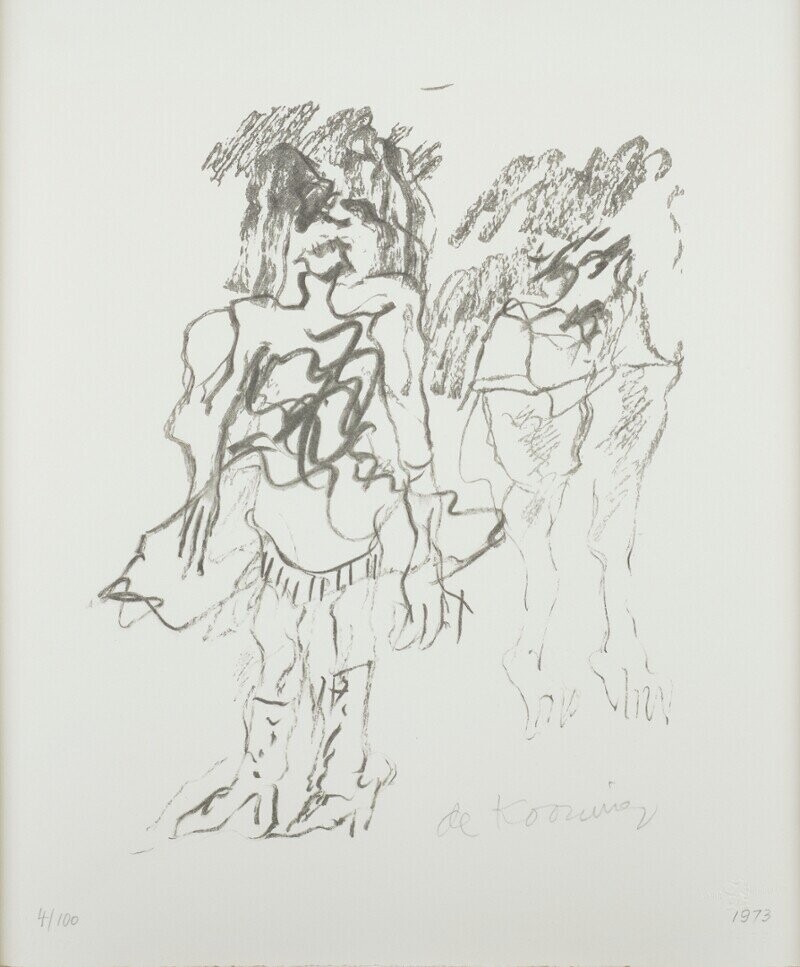
Willem de Kooning
(American, 1904-1997), Two Women, 1973, Lithograph on paper, 18 x 15 in. Museum Purchase from the Wally Findlay Acquisition Fund, 1997.13
A monolith in American Abstract Expressionism, Dutch-born artist Willem de Kooning had a diverse artistic career lasting for over five decades. I first encountered the work of de Kooning in person during 2017 at the Hirshhorn Museum and Sculpture Garden in Washington, DC. As I rounded the bend of the donut-shaped building in the exhibition Masterworks from the Hirshhorn Collection, de Kooning’s Woman/Verso: Untitled of 1948 greeted me from the wall of the gallery. The subject of the painting had a single distinguishable eye, a toothy grin, and multiple arms partially obscured by her yellow hair. The earliest surviving painting in de Kooning’s most famous series, Woman/Verso: Untitled actually represented the artist’s second foray into the application of figural abstraction to depict the bodies of women. He also painted a series of women in the early 1940s, and he would later revisit the subject with this series of monochromatic lithographs in the 1970s.
At first, de Kooning’s grotesque abstractions may appear simple and unplanned. However, the artist spent a surprisingly large amount of time on his compositions. For example, MoMA’s Woman I took a period of two years from 1950 to 1952 to complete. Visitors to the artist’s studio described de Kooning’s artistic process as intermittent–short periods of vigorous activity followed by long sessions of close looking. In fact, many of his figural representations actually began as abstract compositions where the artist would find and accentuate biomorphic details in his gestural brushstrokes. This approach would come to characterize de Kooning’s unique brand of Abstract Expressionism, and it allowed for the creation of wholly abstract works alongside works depicting somewhat recognizable figures. It is likely that de Kooning began this lithograph in much the same way as his paintings–as a collection of abstract lines and shapes that were then guided and transformed under the supervision of his “aesthetic conscience.”
Ultimately, de Kooning’s violently heterosexual depictions of the female figure would stir controversy and attract personal accusations of misogyny. The placement of de Kooning’s Woman I and other paintings in the galleries of MoMA would prompt second-wave feminist scholar Carol Duncan to write the scathing article “The MoMA’s Hot Mamas.” She criticized de Kooning’s manipulation of anatomy as an assertion of ownership over the female body and compared Woman I to contemporary Penthouse magazine advertisements and depictions of mythological Gorgons. It is tempting to read into comparisons to monstrosity in this lithograph; while the figure on the left clearly wears high heel boots, the feet of the figure on the right are distorted, barefoot claws.
De Kooning, unfortunately, passed away after a long battle with Alzheimer’s in 1997. Since his colossal 2011 retrospective at MoMA, de Kooning is now one of the best-known artists of the 20th century. Works by Willem de Kooning will undoubtedly continue to promote critical discussion as they are formally dissected and reexamined by new voices in the scholarly community.
Isaac Gorres
Former Fred Hicks Intern
Read more on this work by Willem de Kooning on our Collection page.
